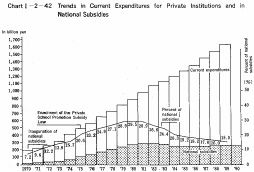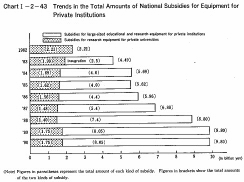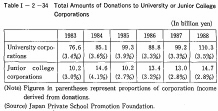| Home > Policy > White Paper, Notice, Announcement > White Paper > JAPAMESE GOVERNMENT POLICIES IN EDUCATION,SCIENCE AND CULTURE 1990 > PART |
||
Considering the important role which private universities, junior colleges and colleges of technology play in the system of higher education in the country, the government, through the Japan Private School Promotion Foundation, has been providing school corporations maintaining these institutions with subsidies for their current expenditures for the education of students and for research activities by the teaching staff).
These subsidies for current expenditures are classified into "general subsidies" and "special subsidies."
"General subsidies" to each institution are computed by multiplying certain unit costs by the numbers of teachers and other personnel and of students, giving some institutions preferential weight in accordance with the level of the provision of staff and physical facilities.
Preferential weight is given to individual institutions (l) if their actual student enrollment is within a certain range of excess or shortage of the prescribed number of student places (weight A), (2) if the number of students per full-time teacher is very small (weight B) or (3) if the proportion of their income from tuition and other student fees spent on educational and research activities (i.e., the education of students and the research activities of teachers) is very high (weight C). (As a result of these weights, unit costs may be increased by 30% at a maximum. If the results are negative, unit costs may be decreased by 70% at a maximum.)
"Special subsidies" are intended to support part of current expenditures for distinctive educational and research activities of private institutions (such as distinctive postgraduate education, distinctive, research projects at research institutes, the acceptance of foreign students and other international exchange activities, contribution to the spread of higher education in geographical areas other than the largest cities, and so forth). "Special subsidies" are granted to private institutions in addition to "general subsidies."
In spite of the recent financial stringency of the government,
the Ministry of Education, Science and Culture has been striving to secure and
increase national subsidies for the current expenditures of private institutions.
The amount of these subsidies for fiscal 1990 was 252,050 million yen, representing
an increase of 3,400 million yen over the previous fiscal year. In particular,
the Ministry has been making special efforts to increase "special subsidies." As
a result, in fiscal 1990 he total amount of "special subsidies" reached 10.4%
of the total national subsidies for the current expenditures of private institutions.
(See Table ![]() -2-33.)
-2-33.)

With the aim of promoting scientific research and information processing education at private institutions and thus contributing to the vitalization of higher education in the country, every year since 1983 the national government has been subsidizing the purchase of large-sized research equipment (which costs 40 million yen per item at a minimum) for undergraduate and graduate departments of private universities, as well as the purchase of large-sized educational equipment for private universities, junior colleges, colleges of technology and advanced courses at special training schools. (The minimum cost of each piece of equipment which can be subsidized is 40 million yen for universities, 30 million yen for junior colleges and colleges of technology and 20 million yen for special training schools.) These subsidies, which are called "Subsidies for the Provision of Educational and Research Equipment for Private Institutions of Higher Education," were inaugurated in 1983 on the basis of the recommendation of the Provisional Commission for Administrative Reform which stressed that emphasis should be put on government assistance to appropriate educational and research projects. In spite of the recent financial stringency of the government, the Ministry of Education, Science and Culture has been striving to increase these subsidies. The Ministry's budget for the1990 fiscal year included 8,050 million yen for these subsidies. Equipment to be subsidized include "most advanced large-sized equipment for graduate schools" useful for distinctive research projects for which there are high demands from society, "large-sized equipment for information processing education" and other large-sized equipment. The amount of a subsidy is equal to one half of the total cost for purchasing a particular piece of equipment.

Apart from these subsidies, every year since 1953 the Ministry
has been subsidizing the purchase of "research equipment (amounting to 5 to 40
million yen per piece of equipment) useful for basic research projects in private
universities. In1957 these subsidies were legally authorized by a Law Concerning
National Subsidies for Research Equipment for Private Universities and under
the name of "Subsidies for Research Equipment for Private Universities." In 1974
these subsidies began to include those for research equipment related to information
processing. The total budget of these subsidies amounted to 1,753,360,000 yen
in fiscal 1990. The amount of a subsidy is equal to two-thirds of the total cost
for the purchase of research equipment (excluding information processing equipment)
and one-half of the total cost for the purchase of information processing equipment.
(See Chart ![]() -2-43.)
-2-43.)

Twenty years have passed since the national subsidies for current expenditures for private institutions were introduced. During the past twenty years these subsidies have contributed to the improvement of the various conditions of educational and research activities at these institutions. This improvement has been reflected in: the reinforcement of the teaching staff; a decrease in the number of students per full-time teacher due to the elimination of excessive intake of students; an increase in expenditures per student; and a decrease in the difference in the amounts of tuition and other student fees between public and private institutions. The national subsidies have also facilitated the stabilization of the financial management of corporations maintaining private institutions.
The total amount of these national subsidies had been gradually increasing until 1982. By 1980 the amount had reached 29.5% of the total current expenditures of private institutions. Since 1982, however, the national share of current expenditures for private institutions has been declining. In 1989 it was as low as 15.0%. This decrease was partly because the Provisional Commission for Administrative Reform recommended that the government refrain from increasing the total amount of national subsidies to private educational institutions and that emphasis in the subsidy be placed on assistance for appropriate and distinctive educational and research projects. It was also partly because an increase in the total amount of the national subsidies was actually restrained due to the financial stringency of the government and due to some financial scandals which took place in a small number of private universities. It will be crucial for the government to strive to secure an adequate total amount of subsidies in the future.
Meanwhile, however, some people have suggested that the government need not grant its subsidies to those private institutions which have not spent an adequate amount of income from student fees on their educational and research activities or to those institutions which enjoy favorable financial conditions. For this reason, on the basis of the recommendations offered by the Provisional Commission for Administrative Reform and by the National Council on Educational Reform, since 1982 the Ministry has incorporated successive improvements in formulas for calculating and allocating national subsidies to private institutions for their current expenditures, with a view to making the allocation of subsidies more efficient and effective and to helping private institutions improve their conditions of educational and research activities on their own initiative. Specifically, the Ministry has incorporated a formula of preferential allocation of subsidies to those private institutions whose conditions of educational and research activities (e.g., the number of students per full-time teacher and educational expenditures per student) are favorable. The Ministry has also increased year by year the proportion of "special subsidies" in the total amounts of subsidies for current expenditures. In particular, in 1989, the Ministry applied more extensively a formula for weighted allocation of subsidies whereby the amount of a subsidy is reduced for a university which enjoy favorable financial conditions and whose level of teachers' salaries is remarkably high. It will be necessary for the Ministry to continue its reexamination of the formulas for allocating subsidies. On the other hand, private institutions are required to strive to ensure a sound management of the national subsidy, lest they should become a focus of criticisms from society. In this connection, it should be noted that, in view of the important social responsibility of private institutions, a code of ethics on the financial management of private institutions was worked out by these institutions on their own initiative.
In order to encourage private institutions to ensure their sound management, in 1983 the Ministry began to take sanctions against private institutions whose administration and management are regarded as conspicuously improper. Specifically, if the Ministry considers it difficult for such a private institution to achieve the objective of national assistance effectively, the Ministry will, in principle, discontinue a subsidy to this institution for five years. So far such sanctions have been applied to five institutions. The Ministry, however, has lately removed its sanctions against four of the five, recognizing the improvement made in the management of these institutions.
The medium- and long-term issues for government aid to private institutions include: how to carry out measures for encouraging private institutions to upgrade, vitalize and diversify their educational and research activities; and how to promote institutions of higher education located in geographical areas other than the largest cities for the coming years beginning in 1992 during which 18-year-olds will be rapidly decreasing.
(2) Loans to private institutionsGovernment-supported loan programs for private educational institutions were initiated by the Private School Promotion Society established in 1952 with the aim of meeting the financial demands of private institutions for the reconstruction of war-damaged buildings. Since 1970 these programs have been under the responsibility of the Japan Private School Promotion Foundation which took over the Society in the same year. The Foundation loans which bear very low interest and are repayable over a long period, have been utilized by private institutions as stable funds. The total annual amount of these loans is approximately 60 billion yen. The loan funds can be used by private educational institutions of all levels (including special training schools and miscellaneous schools) for the following purposes: the purchase of sites; the new and additional construction of buildings; the securing of educational and research facilities and equipment; the restoration of facilities and equipment damaged from calamities; the securing of relevant facilities and equipment needed to protect educational institutions against pollution; etc. The interest of each loan is 7.9% per year (as of October 1990) and the term of repayment of a loan is 20 years. The Foundation's loans are supported by the government's "Financial Investment and Loan Program Fund" and the government's advances to the Foundation's capital funds (the government's advances amounted to 39,300 million yen as of March 1990.)
The total amount of loans provided by the Foundation was 640,600
million yen as of March 1990. Of this total, 412,700 million yen was provided
for university corporations (totaling 297, representing 85.8% of all university
corporations) and76.300 million yen for junior college corporations (totaling
195, representing 72.8%of all junior college corporations.)
One of the critical factors unfavorably affecting the management of the Foundation is the increasing number of corporations which repay loans in a shortened period. (Specifically, many corporations which borrowed funds when the rate of bank interest was high have tended to repay them before the time limit for repayment comes, because the rate of bank interest is now extremely low. The total amount of loans repaid in this way during the years from 1985 to 1989 reached 72,300 million yen.)
Now that the rate of bank interest is going to rise again, it is expected that the number of corporations repaying loans in a shorter period will be gradually decreasing and that more corporations will make positive use of the reliable loans of the Foundation with low interest and with a long term of repayment.
Private institutions of higher education are going to face a rapid decrease in the population aged 18 in the coming years. If they are to secure an adequate number of entrants, they are expected to develop more distinctive activities in education and research, in response to the diverse needs of people for lifelong learning, as well as to the other various needs of people in the age of internationalization and of the spread of information media. It appears to be essential for these institutions to secure new facilities and equipment needed for such activities.
It is necessary for the Foundation to explore these new needs for loans and to adapt its loan programs to them. It is also necessary to disseminate more widely among private institutions information about the characteristics of the loan pro-grams of the Foundation and to improve and expand the loan programs as an integral part of the promotion of private educational institutions.
(3) Favorable measures regarding taxationTaking account of the contribution of private educational institutions to the public interest, the government has taken various special taxation measures favorable to these institutions. At present, all school corporations are exempt from property tax with regard to their educational properties such as school buildings and gymnasiums. They are also exempt from corporation tax and enterprise tax, unless they are carrying out some profit-raising programs. Tax rates for those school corporations undertaking some profit-raising programs are lower than for other (non-school) corporations. If profit income is incorporated into the general accounts of the school corporation, not more than 50% of the income may be recognized as financial loss for the purpose of taxation.
Those corporations or persons who have made donations to school corporations are entitled to be either totally exempt from tax for their donations or partially exempt from tax through gaining a certain proportion (or a certain sum) of income deduction. In particular, those corporations which have made a donation to school corporations may be exempt from tax for the donation if the donation satisfies certain requirements laid down by the Ministry of Finance. (For example, a donation which is made to the Japan Private School Promotion Foundation and which is earmarked to a particular school corporation for the purpose of being used either as part of endowment funds for educational institutions maintained by this corporation or as part of expenditures to be incurred for these institutions.)
Major receipts of income for private educational institutions include student fees, government subsidies, income from the use of property, income from enterprises, donations, loans, and so forth. Private institutions in Japan are more dependent on student fees than American private colleges are.
During recent years the amount of income from donations to university
or junior college corporations has continued to account for only more or less
than 3% of the total general income for these corporations. (See Table ![]() -2-34.)
-2-34.)

With regard to donations to school corporations, the following proposals have been made; (1) the duration for raising donations should be made more flexible, and the procedures for accepting donations be made simpler, with a view to inviting more voluntary contributions from the private sector including charitable persons; (2) more donations for the construction of buildings with the donor's name and for the opening of donated chairs and departments should be actively encouraged; and (3) taxation should be totally or partially exempted through simple formalities for donations for the construction of new universities and faculties or other educational expenditures.
The National Council on Educational Reform also made similar recommendations for the improvement of the conditions for raising donations. Following the recommendations, the government has taken several measures to this effect such as: (1) the widening of the purposes of donations to school corporations the amount of which is totally deducted from the donor's income on which a tax is imposed; (2) the introduction of simpler procedures and eased requirements for donations to the Japan Private School Promotion Foundation with particular recipient school corporations designated; and (3) the extension of the validity of the certificate, from 2 to 5 years, recognizing a school corporation as "special public interest corporation" which can enjoy various favorable treatments on taxation. Private schools and higher education institutions are expected to take advantage of the new arrangements.
If private universities are to carry out distinctive educational and research activities characterized by their individuality, and if they are to maintain and establish a sound base for their management. keeping students' financial burdens to a minimum with the limited financial aid of the government under the present financial stringency, it is essential for private institutions to be encouraged to accept more donations as mentioned above, and to make efforts to improve their financial management by means of making more effective use of their assets and increasing income from their sound profit-raising programs, and by other means. To this end, it is considered to lee very important that the government continue providing special taxation measures favorable to private universities to assist them with their in-dependent management efforts.
| Back to Top | MEXT HOME |